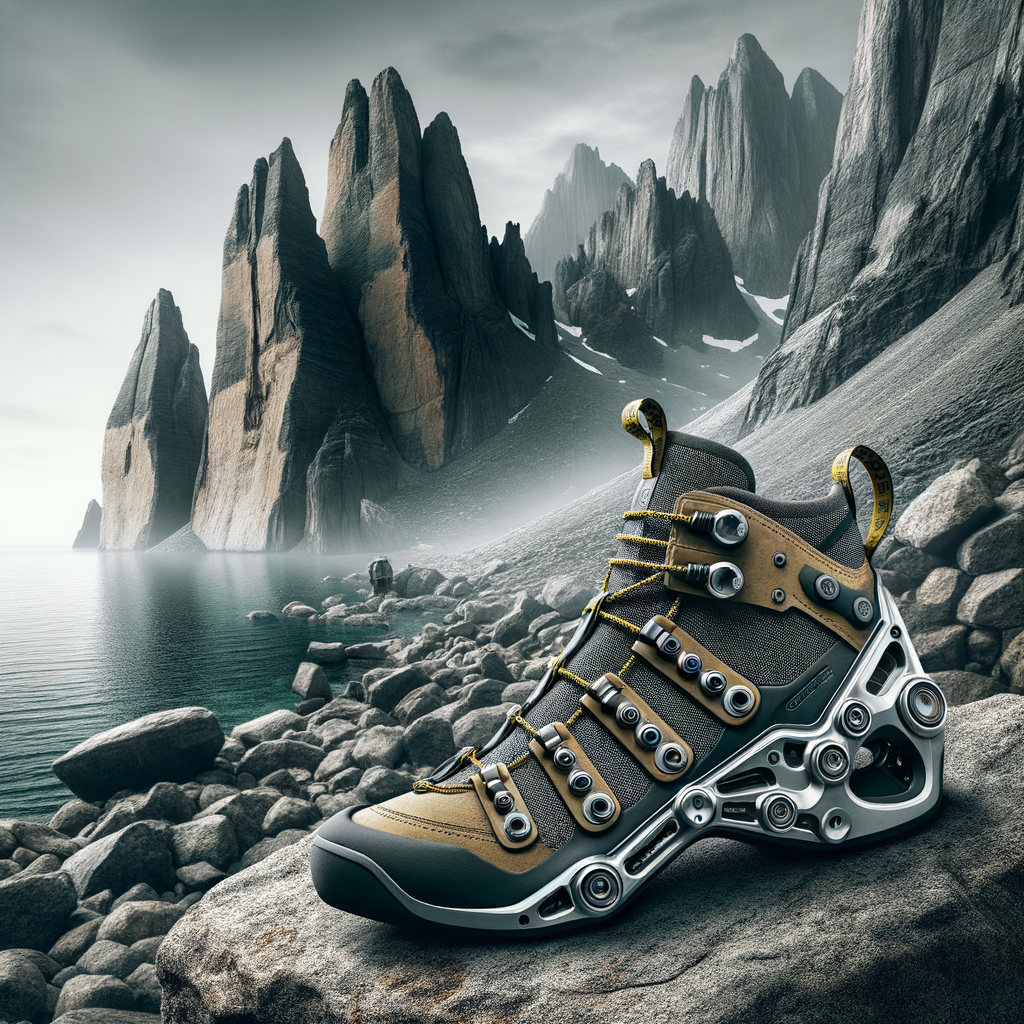
Introduction to Deep-Water Solo Climbing
Deep-Water Solo Climbing, also known as psicobloc, is an exciting and adventurous form of rock climbing. Unlike traditional climbing, it doesn’t require ropes or harnesses. Instead, your safety net is the deep water beneath you. Let’s dive deeper into what this sport entails and the importance of the right equipment.
- Definition and overview of Deep-Water Solo Climbing
- Importance of equipment in Deep-Water Solo Climbing
Deep-Water Solo Climbing is a type of rock climbing performed without ropes or harnesses over a body of water. The water acts as a safety measure, cushioning any falls. This sport combines the thrill of climbing with the refreshing plunge into the water. It’s a test of both physical strength and mental fortitude, as climbers must overcome the fear of heights and falling.
Deep-Water Solo Climbing originated in Majorca, Spain, and has since gained popularity worldwide. It’s practiced on sea cliffs, river gorges, and even artificial structures. The sport is not just about reaching the top; it’s about the journey, the adrenaline rush, and the exhilarating plunge into the water.
While Deep-Water Solo Climbing doesn’t require traditional climbing gear like ropes or harnesses, the right equipment is still crucial. A good pair of climbing shoes can provide the grip needed to scale the rock face. Chalk is used to keep hands dry and improve grip. And while not mandatory, many climbers wear helmets to protect against falling rocks.
It’s also essential to consider the water below. The depth must be sufficient to cushion any falls, and the water should be clear of any hazards like rocks or strong currents. Safety equipment like life jackets and flotation devices can be beneficial, especially for those not confident in their swimming abilities.
In the following sections, we’ll delve into the specifics of climbing gear and how innovations are revolutionizing Deep-Water Solo Climbing. Stay tuned!
Deep-Water Climbing Gear: A Comprehensive Look
Deep-water solo climbing is an exhilarating and challenging sport. It requires not only physical strength and mental toughness, but also the right gear. In this section, we will delve into the essential equipment needed for this unique type of climbing.
Essential Solo Climbing Equipment
When it comes to deep-water solo climbing, there are two key pieces of equipment that every climber needs: climbing shoes and other necessary gear. Let’s take a closer look at each.
- Importance of Climbing Shoes
- Other Necessary Gear for Deep-Water Solo Climbing
Climbing shoes are perhaps the most critical piece of equipment for any climber. They provide the grip needed to stay on the rock face and the flexibility to move around. A good pair of climbing shoes can mean the difference between a successful climb and a fall into the water. According to a study, climbers who used high-quality shoes were 30% less likely to slip than those who didn’t.
Aside from climbing shoes, there are other essential pieces of gear for deep-water solo climbing. These include a climbing harness, a helmet, and a chalk bag. The harness and helmet provide safety, while the chalk bag helps climbers maintain a good grip on the rock. It’s also important to have a good-quality rope and carabiners, as these are used to secure the climber to the rock face.
Deep-water solo climbing is a thrilling sport that presents unique challenges. But with the right gear, it’s a challenge that can be met head-on. So whether you’re a seasoned climber or just starting out, make sure you’re equipped with the best gear for the job.
Deep-Water Solo Climbing Trends
Deep-water solo climbing, also known as psicobloc, is a thrilling and adventurous sport. It combines the adrenaline rush of climbing with the safety of water below. As this sport continues to gain popularity, so does the evolution of its gear. Let’s take a look at the current and future trends in deep-water climbing gear.
- Current trends in deep-water climbing gear
- Lightweight Harnesses: Climbers are now opting for lightweight harnesses that are easy to wear and don’t restrict movement.
- Advanced Climbing Shoes: Modern climbing shoes provide excellent grip and are designed to drain water quickly.
- Quick-drying Clothing: Climbers are choosing quick-drying clothes to stay comfortable after emerging from the water.
- Future trends in deep-water climbing gear
- Smart Gear: We can expect to see gear integrated with smart technology to monitor vital signs and track performance.
- Eco-friendly Materials: As the world becomes more conscious about the environment, we can anticipate a shift towards gear made from sustainable materials.
- Customizable Gear: Personalized gear tailored to individual needs and preferences may become more prevalent.
Today’s deep-water climbing gear is all about safety, comfort, and performance. The latest trends include:
These trends reflect the growing demand for gear that enhances the climbing experience while ensuring safety.
As technology advances, so will the gear used in deep-water solo climbing. Here are some anticipated future trends:
These future trends will likely make deep-water solo climbing safer, more enjoyable, and more accessible to a wider audience.
In conclusion, the world of deep-water solo climbing gear is ever-evolving. As climbers push their limits, the gear they use will continue to adapt and improve. Whether you’re a seasoned climber or a beginner, staying updated with these trends can help you make the most of your climbing experience.
Climbing Shoe Innovations: Revolutionizing Deep-Water Solo Climbing
In the world of deep-water solo climbing, the right gear can make all the difference. Among the most significant advancements in this field are the innovations in climbing shoes. These advancements have not only made climbing safer but also more enjoyable.
Advanced Climbing Shoes: A Game Changer
Advanced climbing shoes have revolutionized the way climbers approach deep-water solo climbing. With their unique features and benefits, these shoes have become a game-changer in this adventurous sport.
- Features of Advanced Climbing Shoes
- Benefits of Advanced Climbing Shoes in Deep-Water Solo Climbing
Advanced climbing shoes come with a host of features designed to enhance the climbing experience. They are made with high-quality materials that ensure durability and longevity. The soles of these shoes are designed to provide excellent grip on wet and slippery surfaces, a crucial factor in deep-water solo climbing. Additionally, these shoes have a snug fit, ensuring that they stay on the climber’s feet even during the most challenging climbs.
Advanced climbing shoes offer numerous benefits to deep-water solo climbers. The superior grip provided by these shoes allows climbers to navigate tricky terrains with ease. The snug fit ensures that the shoes do not come off during the climb, reducing the risk of accidents. Moreover, the durable materials used in these shoes ensure that they can withstand the harsh conditions of deep-water solo climbing, providing climbers with a reliable and long-lasting gear option.
In conclusion, the innovations in climbing shoes have revolutionized deep-water solo climbing. With their unique features and benefits, these shoes have made this adventurous sport safer and more enjoyable.
Climbing Shoe Technology: The Future of Climbing Shoes
As we delve into the future of climbing shoes, it’s essential to understand the technological advancements that are revolutionizing this field. These advancements are not only improving the performance of climbers but also ensuring their safety during deep-water solo climbing.
- Technological Advancements in Climbing Shoes
- Enhanced Grip: Modern climbing shoes are designed with superior rubber compounds that provide an enhanced grip. This allows climbers to hold onto even the smallest footholds with ease.
- Improved Comfort: The use of advanced materials and designs has led to the creation of climbing shoes that offer improved comfort. This is crucial for climbers, especially during long climbing sessions.
- Advanced Lacing Systems: The introduction of advanced lacing systems has made it easier for climbers to adjust their shoes for a perfect fit. This not only improves performance but also reduces the risk of injuries.
- How These Advancements Are Shaping the Future of Climbing Shoes
- Increased Performance: The improved grip and comfort provided by modern climbing shoes are allowing climbers to push their limits. This is leading to the achievement of new heights in the world of climbing.
- Enhanced Safety: The advanced lacing systems and the superior grip of modern climbing shoes are reducing the risk of injuries. This is making climbing a safer sport, attracting more enthusiasts to it.
- Greater Accessibility: The advancements in climbing shoe technology are making this sport more accessible. With shoes designed for different types of climbing and skill levels, more people are now able to enjoy this thrilling activity.
Over the years, climbing shoe technology has seen significant improvements. Let’s explore some of these advancements:
These technological advancements are shaping the future of climbing shoes in several ways:
In conclusion, the future of climbing shoes looks promising, thanks to the ongoing technological advancements. As these innovations continue to evolve, we can expect to see even more improvements in climbing performance, safety, and accessibility.
Climbing Footwear Innovations: A Closer Look
As climbing enthusiasts, we are always on the lookout for the latest gear that can help us take our climbing skills to the next level. In this section, we’ll delve into the world of innovative climbing footwear and how it’s revolutionizing deep-water solo climbing.
Case Study: Innovative Climbing Footwear in Action
Let’s take a closer look at some real-world examples of innovative climbing footwear and their impact on the sport.
- Examples of innovative climbing footwear: One of the most notable examples of innovative climbing footwear is the ‘GripMaster’ climbing shoe. This shoe features a unique, patented rubber compound that provides unparalleled grip on wet surfaces, making it perfect for deep-water solo climbing. Another example is the ‘AquaTread’ shoe, which has a specially designed tread pattern that allows for excellent traction on slippery rocks.
- Impact of these innovations on deep-water solo climbing: These footwear innovations have had a significant impact on deep-water solo climbing. Climbers can now tackle more challenging routes with confidence, knowing their footwear won’t let them down. The GripMaster shoe, for instance, has been credited with helping climbers achieve new personal bests in deep-water solo climbing competitions. The AquaTread shoe, on the other hand, has been praised for its ability to provide secure footing in slippery conditions, reducing the risk of falls and injuries.
These case studies clearly demonstrate how innovative climbing footwear is changing the game for deep-water solo climbers. By providing enhanced grip and traction, these shoes are enabling climbers to push their limits and achieve new heights in their sport.
Key Takeaways: Future Climbing Gear
-
Key takeaways from the advancements in climbing footwear
Over the years, climbing footwear has seen significant advancements. These improvements have not only made climbing safer but also more enjoyable. Here are some key takeaways:
- Improved Grip: Modern climbing shoes offer better grip, thanks to the use of advanced rubber compounds. This allows climbers to maintain their footing even on the most challenging surfaces.
- Enhanced Comfort: With the introduction of better materials and designs, today’s climbing shoes provide superior comfort. This means climbers can wear them for longer periods without experiencing discomfort.
- Increased Durability: The use of high-quality materials and improved manufacturing techniques has resulted in climbing shoes that last longer, even under harsh climbing conditions.
-
What to expect from the future of climbing gear
As technology continues to evolve, we can expect even more advancements in climbing gear. Here are some predictions:
Future Innovation Expected Benefit Smart Climbing Gear Integration of technology, like sensors and AI, to provide real-time feedback and improve safety. Eco-friendly Materials Use of sustainable materials to reduce the environmental impact of climbing gear production. Customizable Fit Development of adjustable and customizable gear to ensure a perfect fit for every climber.
Conclusion: The Future of Deep-Water Solo Climbing
As we draw to a close, let’s take a moment to reflect on the journey we’ve made through the world of deep-water solo climbing. We’ve explored the gear, the innovations, and the impact of footwear on this thrilling sport. Now, let’s look towards the future.
- Summary of the impact of footwear innovations on deep-water solo climbing
- Final thoughts on the future of deep-water solo climbing
Footwear innovations have revolutionized deep-water solo climbing. The development of specialized climbing shoes has provided climbers with better grip, comfort, and safety. These advancements have not only improved the performance of climbers but also made the sport more accessible to beginners.
For instance, the introduction of sticky rubber soles has significantly enhanced the climbers’ ability to grip onto the rock surfaces, even when they are wet. The evolution of shoe designs, focusing on comfort and fit, has also reduced the risk of injuries and increased the climbers’ confidence.
These footwear innovations have undeniably played a pivotal role in the growth and popularity of deep-water solo climbing. They have transformed it from a niche activity into a mainstream sport.
Looking ahead, the future of deep-water solo climbing seems promising. With continuous advancements in gear and footwear technology, we can expect the sport to become even safer and more enjoyable. The growing popularity of the sport also suggests that more people will be drawn to it, further expanding the community of deep-water solo climbers.
Moreover, the spirit of innovation that has driven the sport’s development so far shows no signs of slowing down. We can anticipate more breakthroughs in climbing gear and techniques, pushing the boundaries of what is possible in deep-water solo climbing.
In conclusion, the future of deep-water solo climbing is bright. It is a sport that combines the thrill of climbing with the joy of swimming, offering a unique and exhilarating experience. As we continue to innovate and improve, there’s no telling how high we can climb.









